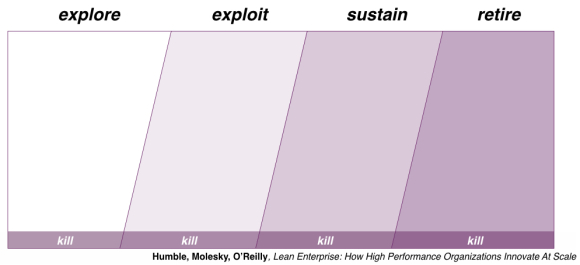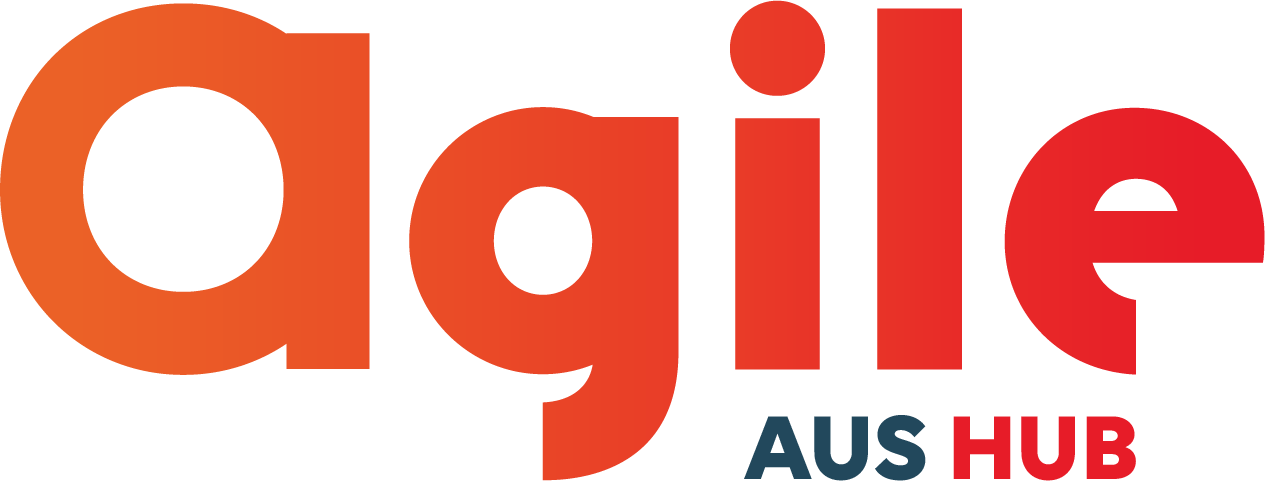
Lean PMO: Managing the Innovation Portfolio
AgileAus17 speaker Barry O’Reilly takes us through the four main domains of Lean enterprises: explore, exploit, sustain and retire.
One of the first exercises I run with executive teams is mapping their business portfolio to visualize current work in progress and how it aligns to the overall business strategy. Without exception, every time I run this exercise the gap between current state and desired state is far wider than every executive believed, hoped or even imagined.

Portfolio mapping requires taking an end-to-end view of the lifecycle of initiatives in your organization.
In the text Lean Enterprise: How High Performance Organizations Innovate at Scale, Jez Humble, Joanne Molesky and I consider four main domains:
- Explore early stage initiatives that are bets for the future with high degrees of uncertainty
- Exploit initiatives that have achieved product-market fit and the organization wants to grow and scale
- Sustain initiatives that have become repeatable and scalable business models, products or services that drive the majority of revenue for the organization
- Retire initiatives that are long lived, no longer beneficial (even limiting) to the organization’s future success or strategy and should be sunset from the portfolio

Initiatives that do not achieve desired outcomes in any domain should be killed, and their investment transferred to other initiatives.
High performance organizations focus on building capability to continuously move initiatives through the model from Explore to Retire. They understand that using the same strategy, practices and processes across the entire portfolio will result in negative outcomes and results.
Poorly managed organizations tend to use the same standardized approach for all domains. They fail to recognize the need to adapt their analysis, evaluation and control mechanisms to design a system that will provide the correct amount of governance and measurement to enable business leaders to make high-quality decisions based on learning outcomes and data derived from executing the work in each domain.
Typically these companies’ portfolios are orientated solely toward high revenue generating initiatives. Valuable cash cows become prized assets, protected and milked dry. Lean Enterprises, however, know that one day the milk will run dry.
Explore
New initiatives are inherently risky. When aiming to explore a new business model or product it is imperative that investment is limited by setting boundaries around time, scope, financial investment and risk. We do this not because we are cheap. We do this to create ‘safe to fail’ experiments and build in quick feedback loops to understand if we are achieving the desired outcomes.

In the Explore domain our goal is to test the business or product hypothesis at speed using a cross-functional team to experiment with the customers the solution is targeted at. By designing fast and frequent feedback loops into the team’s exploration we can limit investment, maximize learning and avoid creating ‘bet the business’ scenarios that are too big to fail.
Limiting investment into smaller bets allows us to make more bets, enabling us to test many ideas to discover what works and what doesn’t. This is the principle of optionality applied to business model innovation and product development.

Most of the ideas that we believe are great aren’t actually that great at all. By creating optionality in how we design our testing process we can create many opportunities to learn, not just one.
Yammer used a concept of 10×2 to design feedback loops and limit investment in early stage ideas. Their approach constrained teams to no more than 10 and no fewer than 2 people when exploring ideas. Also their iterations could be no longer than 10 weeks and no shorter than 2 weeks before teams had to demonstrate their achievements designing feedback loops directly into the development system.
Principles and capabilities of Explore:
- Cross-functional multidisciplinary teams
- Make lots of small bets
- Boundaries of time, scope, financial investment and risk
- Design experiments are safe to fail (the only true failure is the failure to learn)
- Create a sense of urgency
- Demonstrable evidence of value to proceed
Exploit
For those few initiatives that achieve escape velocity and exit the Explore domain, teams can continue with a sufficient level of confidence that they are building the right thing, now they must embrace building it the right way.
Lean Enterprises understand that the project paradigm is broken, only further propagating organizational silos, conflicting priorities and measures of success. They understand the importance of enabling cross-functional teams to experiment directly with their customers and users. Effort and measures of success are tied to business outcomes not output.
As the team collects data from experimenting with real customers and users it improves its understanding of how the business model, product or service is performing. The team can then develop more targeted and sophisticated hypotheses based on the knowledge created from genuine user feedback.

Amazon designed the concept of Two Pizza teams – independent, long lived customer facing teams that were small enough to be fed by two pizzas. This enables context to be held within the group as the business model, product or service grows, while also allowing the team to become autonomous and learn together at speed. Leadership can then continuously evaluate how the initiative is performing based on frequent feedback loops, and can help to make further investment decisions on how to scale it up, down or to kill it based on the outcomes achieved.
Principles and capabilities of Exploit:
- Create end-to-end customer facing teams, not project teams
- Continuous evaluation funding model
- Target condition is to achieve break-even point
- Data-driven, fact-based decisions based on accumulated knowledge
- Maintain a sense of urgency
- Set a vision, trust the team to get there, clear blockers and support as they proceed
- Make knowledge sharing and organisational learning easy
Sustain
The majority of large organizations have built their entire business on a single business model and/or supporting products that achieved product-market fit and continued to grow beyond early expectations. They have extended their market, region, and/or sector to achieve exceptional financial success and achieve wide customer adoption and reach.

The challenge they meet is how to avoid ‘feature fallacy’ – the fallacy that simply adding new features will add more value. This manifests itself as overloaded products with features, tools and customizations that customers often never use or are even aware of.
Think of a product you have used for a number of years. Are you aware of all the new useful additions to it? Adding new features does not equal adding more value to customers and users. The feature fallacy often represents wasted effort and investment that could be spent elsewhere.
Etsy design for continuous experimentation. Teams at Etsy work closely with product, marketing, and engineering to scout, build, instrument and improve Etsy’s product portfolio to make sure that they are improving business outcomes for all their stakeholders – customers and users included.
The goal is to use data-driven decisions based on usage and profitability to enhance what customers desire – not just copy what competitors release or what HIPPOs (HIghest Paid Person’s Opinion) want to have.
By continually adding more and more features to existing products, organizations end up with huge monolith applications that are difficult, slow and costly to change or build upon.
The trick is to break out new ideas, implement them as an Explore initiative and drive them through the end-to-end lifecycle flow again. This provides all the benefits and rigor of each stage while building the capability to continually create new business opportunities for future ongoing success.
Principles and capabilities of Sustain:
- Beware of the feature fallacy
- Focus on what is valuable – where can we win?
- Don’t get lazy. Success hides suboptimal issues
- Keep discipline with fact and evidence-based decisions
- What is being used, improved or removed?
- How could we disrupt or get disrupted?
Retire
All good things must come to an end. The difficulty for most organizations is that many systems in their portfolio are not well understood. Often the people that built the original system long ago on a ‘project’ have left the company. No one knows how to change, adapt or turn off the system or what impact it may have. Fear runs through the organization because the entire company’s business model is dependent on a COBAL program running on a 486. It may sound like a joke, but this is the reality for most organizations.
High performance organizations continuously seek to reduce the complexity of their systems to free up people and investment to Explore new opportunities. By simplifying their systems they are able to innovate faster, cheaper and more frequently.
Ask yourself the question: “When was the last time we sunset a system, product or feature in our team?” If you can’t remember then it is a smell. Over time the weight to legacy systems and technical debt will grind your innovation capability to a halt. Keep it within control. Remember that effort not spent on keeping legacy systems alive frees up opportunity to focus on new initiatives.
Principles and capabilities of Retire:
- Has it served its purpose? Can we sunset it?
- It is providing value? Kill it if it is not.
- Are there better opportunities to invest in?
- Continually look to reduce product and system complexity
- Simplifying helps to support further innovation
- Free up funds and capability
Conclusion
Business models are transient and prone to disruption. If your organization is reliant on a single business model, product or service to guarantee its ongoing survival then safe to say it is in a precarious state. You’re only one technology innovation, customer loyalty switch or economic decision away from irrelevance.

To be successful, a company should have a portfolio of products with different growth rates and different market shares. The portfolio composition is a function of the balance between cash flows. High growth products require cash inputs to grow. Low growth products should generate excess cash. Both kinds are needed simultaneously.
Lean Enterprises know that building the capability to continuously seek out new business models, products and services is the key to ensuring their future business relevance, growth and evolution.
If your executive team is unclear on how your portfolio is performing and what initiatives you are exploring, exploiting, sustaining and retiring, get a cross-functional group together and map out your portfolio to visualize your work in progress. Ask if it is achieving the desired outcomes and aligned to your business strategy and objectives.
Share the results of the exercises with your teams and business leaders. Then start getting deliberate about investment of time, effort and people in becoming the business you want to be.
References
- Read Part 1 of the Lean PMO Series, Explore vs. Exploit.
- Read more in our book, Lean Enterprise: How High Performance Organization Innovate At Scale.
This was originally published on Barry O’Reilly’s website.
Find out more about Barry O’Reilly’s 2017 Agile Australia workshops. Barry will also be speaking at AgileAus 17 next 22-23 June in Sydney!

Stay in the loop
To receive updates about AgileAus and be subscribed to the mailing list, send us an email with your first name, last name and email address to signup@agileaustralia.com.au.

0 Comments